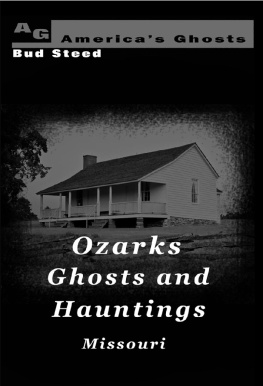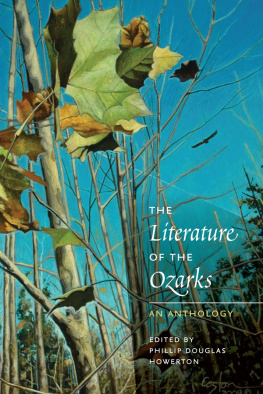SERIES EDITORS PREFACE
What politician wouldnt die for Benjamin G. Raders origin story? Born in one of the most remote places in a region renowned for its remoteness. First ten years of life lived in a log cabin. It may have been better served for someone in the publics eye, but being raised in a log cabin wasnt totally wasted on a historian, as this book proves. Retirements another thing Ben has had no interest in wasting. Some people prune rose bushes, others go RVing. Esteemed historians sometimes craft unique studies that deepen our understanding of family, region, and the human condition.
I can think of no better work to launch our Ozarks Studies series than Down on Mahans Creek. Placing the Ozarks within the broader context of the Upland South, it is at once a meticulously researched community study, a model for crafting scholarly yet accessible family history, and an insightful examination of popularly held assumptions about the people who called the rural Ozarks home in the nineteenth and early twentieth centuries. It is a book that places region and the perception of region front and center, without becoming too esoteric and without ignoring the larger questions that any good topic always poses.
My institution and Bens alma mater, Missouri State University, has long carried a torch for Shannon County, Missouri, the location of Mahans Creek. A collaborative project in the late 1970s and early 1980s produced two documentary films based almost exclusively on footage recorded in the county, one of the poorest in the state and perhaps the most remote and undeveloped. The same project spawned historical studies, oral histories, and multimedia presentations, such as Sassafras: An Ozarks Odyssey. The documentariesespecially the beautiful, stirring, and award-winning first one, Shannon County: Homemanage to evoke the spirit of a preindustrial, Arcadian existence even as they deal with a heritage that includes a massive logging and lumber boom in the early 1900s. Shannon County is the kind of place that tends to heighten our sense of nostalgia. Its the kind of place that comes nearer to satisfying our preconceptions of the Ozarks than just about any other place you can visit.
Thus, Down on Mahans Creek serves as the perfect antidote to the brain-altering substances that generate nostalgiaor are generated by it. Which is not to suggest that Ben Rader, or any historian for that matter, is immune to the powerful drug of sepia-toned memory. As a child of Mahans Creek, whose family left for better opportunities and greener pastures elsewhere, Bens attachment to the idea of the place is undoubtedly strong and influenced his understanding of his familys and his regions past throughout his lifetime. But, as both an insider and outsider (someone who grew up both in and out of the community) and a professional historian, he is able to dig beneath the surface of the story, to separate folklore from fact and image from reality. Leveling the clear-eyed gaze of the historian on his familys history and community, Ben Rader shows us a people and place shorn of romanticism but not stripped of vitality and occasional peculiarity. If all you know about Shannon County and the rest of the rural Ozarks is what youve seen on Shannon County: Home or what youve read in glossy travel magazines and books of tall tales, then you may be surprised at the lives and times revealed in these pages. Not bad for a little retirement project.
Brooks Blevins
PREFACE
My Journey into Ozarks History
In 1933, my grandfather Edward Martin Sam Rader let family members unfamiliar with his ways know who he was. I live in the backwoods, and I love the women, he wrote in the familys monthly newsletter. He loved women, in general, but he had a favorite, Ada May Pummill, whom he had married in 1896. Ada enthralled him with her long, black hair, her haunting eyes, her wit, and her good humor. And he loved the backwoods of the Missouri Ozarks, especially Mahans Creek with its spawning yellow suckers and its swimming holes of cold, clear water. Sam relished the cornbread that Ada baked to a golden brown in a greased cast-iron skillet. And he loved his hounds, in particular, Caruso, whose voice when echoing up and down the hollows reminded him of the great Italian tenor whom he had heard sing on the familys Victrola. Sam may have lived in what he described as the backwoods, but he was not unfamiliar with ways of the outside world.
For seventeen years, Sam had the good fortune of enjoying all of his loves at once, but in 1913 Ada died. He not only lost his mate but suddenly faced the prospect of rearing seven children alone. He sank into a deep melancholia. He needed a new wife and, after an appropriate period of mourning, set about looking for one. He learned of a winsome widow who lived in the nearby town of Winona. They seemed a good match since Sam offered her a homehe owned a pretty good farm on Mahans Creekand she even liked Sams rambunctious children. But when Sam proposed marriage, she made an unexpected demand. She told him he had either to choose her or his hounds. Sam chose the hounds.
Fundamentally, Down on Mahans Creek is an effort to understand why Sam elected to keep his hounds rather than wed the Winona widow. Of course, it may be that his decision sprang from specifics regarding him or the widow (whose name has been lost to history) that have not survived, but a full understanding of his choice requires a scrutiny into the history of the ways of his neighborhood and his family. Hence, in this book I try to reconstruct the fundamental customs, beliefs, and behaviors that governed the lives of the families residing on the Mahans Creek watershed of the Missouri Ozarks from its settlement in the nineteenth century to the mid-twentieth century. Families are of key importance to the story. In 1931, the Current Wave, the weekly published in Eminence, Missouri, a town near Sams farm, put the point this way: Family life is a powerful force in the hills and has a great influence in shaping the morals and manners and customs of a people who have their feet deeply set in the soil.
I began this enquiry with an excess of confidence. While I had had no formal training in Ozarks history, I had done some reading in the subject, and, above all else, I counted on the knowledge that I had garnered from my firsthand experience. After all, I had been born on Mahans Creek and had lived there in a log cabin for the first ten years of my life. Plowing ahead with unrestrained hubris, I early on embraced the conclusion that the families resident in the Mahans Creek neighborhood were latter-day representatives of the Scots Irish (usually called Scotch Irish in America) who had migrated to America mostly in the eighteenth century. Put slightly differently, my central ideaalas, not an original onewas that modern Ozarks folkways had direct origins in Northern Ireland and Scotland and had changed little over the centuries since then. Bluntly speaking, then, Sams decision reflected the continuity of his family culture from the mists of eighteenth-century British history to the early twentieth-century Ozarks.



 The paper used in this publication meets the minimum requirements of the American National Standard for Permanence of Paper for Printed Library Materials Z39.48-1984.
The paper used in this publication meets the minimum requirements of the American National Standard for Permanence of Paper for Printed Library Materials Z39.48-1984.






